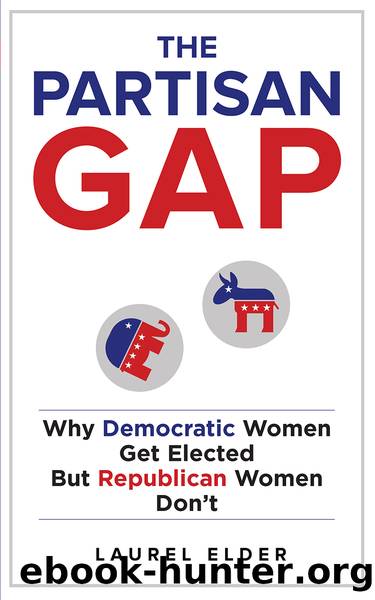The Partisan Gap by Laurel Elder

Author:Laurel Elder
Language: eng
Format: epub
Publisher: NYU Press
Democratic Party Culture and the Recruitment of Women to Congress
Jo Freemanâs foundational work on political party culture in the United States characterized the Democratic Party as having an open and decentralized culture, where power flows upward, and where group identities and group-based activism are viewed as legitimate and valuable.10 She argued that the decentralized nature of the Democratic Party culture made it particularly open to demands from previously marginalized groups, including women and racial and ethnic minority groups. In their more recent analysis of party culture, Grossman and Hopkins explicitly build on Freemanâs analysis of party culture and argue that the Democratic Party is best understood âas a coalition of social groups seeking concrete government actionâ as opposed to the Republican Party, which is structured around ideology and more specifically conservatism.11 In other words, the Democratic Party views activists making group-based demands and groups vying to shape party policy as the norm, rather than as an act of disloyalty toward the party or the partyâs liberal ideology. Cooperman and Crowder-Meyer further reaffirm this characterization of the Democratic Party culture, arguing that âthe Democratic Party is essentially organized to hear and respond to group-based demands.â12
The distinctively decentralized and open culture of the Democratic Party has a number of implications for the recruitment of women. Most important, it has allowed feminists and groups demanding increased representation for women to gain a strong foothold within the partyâs organizational structure. As Freeman describes it, it is not so much that feminists were welcomed by the Democratic Party, but rather that feminists marched in, made demands, and became a legitimate force in shaping party policies.13 In this way, activists demanding womenâs representation became part of the fabric of the Democratic Party and were able to further pursue the goal of increased womenâs representation from within the party. Finally, the open structure of the Democratic Party has enabled it to partner productively with an extended network of groups, most prominently EMILYâs List, that are single-mindedly focused on electing more Democratic women to office. This chapter now turns to discuss each of the ways Democratic Party culture has impacted the recruitment of women.
Download
This site does not store any files on its server. We only index and link to content provided by other sites. Please contact the content providers to delete copyright contents if any and email us, we'll remove relevant links or contents immediately.
The Secret History by Donna Tartt(18951)
The Social Justice Warrior Handbook by Lisa De Pasquale(12170)
Thirteen Reasons Why by Jay Asher(8849)
This Is How You Lose Her by Junot Diaz(6839)
Weapons of Math Destruction by Cathy O'Neil(6221)
Zero to One by Peter Thiel(5736)
Beartown by Fredrik Backman(5683)
The Myth of the Strong Leader by Archie Brown(5463)
The Fire Next Time by James Baldwin(5390)
How Democracies Die by Steven Levitsky & Daniel Ziblatt(5175)
Promise Me, Dad by Joe Biden(5117)
Stone's Rules by Roger Stone(5055)
A Higher Loyalty: Truth, Lies, and Leadership by James Comey(4909)
100 Deadly Skills by Clint Emerson(4883)
Rise and Kill First by Ronen Bergman(4741)
Secrecy World by Jake Bernstein(4703)
The David Icke Guide to the Global Conspiracy (and how to end it) by David Icke(4659)
The Farm by Tom Rob Smith(4468)
The Doomsday Machine by Daniel Ellsberg(4452)
